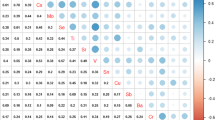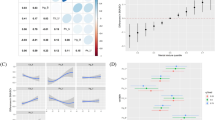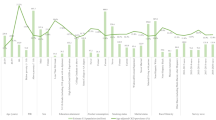Abstract
Assessing the effects of heavy metals (HMs) on kidney stone is often limited to analyzing individual metal exposures, with studies on the effects of exposure to mixtures of HMs being scarce. To comprehensively evaluate the relationship between exposure to mixed HMs and kidney stones, we analyzed data from the National Health and Nutrition Examination Survey (NHANES) from 2007–2016, which included 7809 adults. We used multiple statistical methods, including multiple logistic regression models, weighted quantile sum (WQS) regression, quantile g-computation (qgcomp) and bayesian kernel machine regression (BKMR), to assess the association between single HM and mixed exposure to HMs and kidney stones. Firstly, in single exposure analysis, urinary cadmium (Cd) and cobalt (Co) demonstrated a positive association with the risk of kidney stones. Secondly, various other approaches consistently revealed that mixed exposure to HMs exhibited a positive association with kidney stone risk, primarily driven by Cd, Co, and barium (Ba) in urine, with these associations being particularly notable among the elderly population. Finally, both BKMR and survey-weighted generalized linear models consistently demonstrated a significant synergistic effect between urinary Co and urinary uranium (Ur) in elevating the risk of kidney stones. Overall, this study provides new epidemiological evidence that mixed exposure to HMs is associated with an increased risk of kidney stones. Further prospectively designed studies are needed to confirm these findings.



Similar content being viewed by others
Data availability
The dataset used can be found in the NHANES repository.
References
Bakulski KM, Seo YA, Hickman RC, Brandt D, Vadari HS, Hu H, Park SK (2020) Heavy Metals Exposure and Alzheimer’s Disease and Related Dementias. J Alzheimers Dis 76:1215–1242
Barr DB, Wilder LC, Caudill SP, Gonzalez AJ, Needham LL, Pirkle JL (2005) Urinary creatinine concentrations in the U.S. population: implications for urinary biologic monitoring measurements. Environ Health Perspect 113:192–200
Bellavia A, James-Todd T, Williams PL (2019) Approaches for incorporating environmental mixtures as mediators in mediation analysis. Environ Int 123:368–374
Bobb JF, Valeri L, Claus Henn B, Christiani DC, Wright RO, Mazumdar M, Godleski JJ, Coull BA (2015) Bayesian kernel machine regression for estimating the health effects of multi-pollutant mixtures. Biostatistics 16:493–508
Bobb JF, Claus Henn B, Valeri L, Coull BA (2018) Statistical software for analyzing the health effects of multiple concurrent exposures via Bayesian kernel machine regression. Environ Health 17:67
Buser MC, Ingber SZ, Raines N, Fowler DA, Scinicariello F (2016) Urinary and blood cadmium and lead and kidney function: NHANES 2007–2012. Int J Hyg Environ Health 219:261–267
Carrico C, Gennings C, Wheeler DC, Factor-Litvak P (2015) Characterization of Weighted Quantile Sum Regression for Highly Correlated Data in a Risk Analysis Setting. J Agric Biol Environ Stat 20:100–120
Chen L, Sun Q, Peng S, Tan T, Mei G, Chen H, Zhao Y, Yao P, Tang Y (2022) Associations of blood and urinary heavy metals with rheumatoid arthritis risk among adults in NHANES, 1999–2018. Chemosphere 289:133147
Chen QY, DesMarais T, Costa M (2019) Metals and Mechanisms of Carcinogenesis. Annu Rev Pharmacol Toxicol 59:537–554
Dallas CE, Williams PL (2001) Barium: rationale for a new oral reference dose. J Toxicol Environ Health B Crit Rev 4:395–429
Danziger J, Dodge LE, Hu H, Mukamal KJ (2022) Susceptibility to Environmental Heavy Metal Toxicity among Americans with Kidney Disease. Kidney 360(3):1191–1196
Daudon M, Frochot V, Bazin D, Jungers P (2018) Drug-Induced Kidney Stones and Crystalline Nephropathy: Pathophysiology, Prevention and Treatment. Drugs 78:163–201
Deng J, Yu B, Chang Z, Wu S, Li G, Chen W, Li S, Duan X, Wu W, Sun X, Zeng G, Liu H (2022) Cerium oxide-based nanozyme suppresses kidney calcium oxalate crystal depositions via reversing hyperoxaluria-induced oxidative stress damage. J Nanobiotechnology 20:516
Desquilbet L, Mariotti F (2010) Dose-response analyses using restricted cubic spline functions in public health research. Stat Med 29:1037–1057
Dhondup T, Kittanamongkolchai W, Vaughan LE, Mehta RA, Chhina JK, Enders FT, Hickson LJ, Lieske JC, Rule AD (2018) Risk of ESRD and Mortality in Kidney and Bladder Stone Formers. Am J Kidney Dis 72:790–797
Diamond GL, Thayer WC, Brown JS, Burgess M, Follansbee MH, Gaines LGT, Klotzbach JM (2019) Estimates of urinary blood lead clearance and its relationship to glomerular filtration rate based on a large population survey. J Toxicol Environ Health A 82:379–382
Domingo-Relloso A, Grau-Perez M, Briongos-Figuero L, Gomez-Ariza JL, Garcia-Barrera T, Duenas-Laita A, Bobb JF, Chaves FJ, Kioumourtzoglou MA, Navas-Acien A, Redon-Mas J, Martin-Escudero JC, Tellez-Plaza M (2019) The association of urine metals and metal mixtures with cardiovascular incidence in an adult population from Spain: the Hortega Follow-Up Study. Int J Epidemiol 48:1839–1849
Dong F, Jiang S, Tang C, Wang X, Ren X, Wei Q, Tian J, Hu W, Guo J, Fu X, Liu L, Patzak A, Persson PB, Gao F, Lai EY, Zhao L (2022) Trimethylamine N-oxide promotes hyperoxaluria-induced calcium oxalate deposition and kidney injury by activating autophagy. Free Radic Biol Med 179:288–300
Fang L, Zhao H, Chen Y, Ma Y, Xu S, Xu S, Pan G, Cai G, Shuai Z, Pan F (2023) The combined effect of heavy metals and polycyclic aromatic hydrocarbons on arthritis, especially osteoarthritis, in the U.S. adult population. Chemosphere 316:137870
Faroon O, Ashizawa A, Wright S, Tucker P, Jenkins K, Ingerman L, Rudisill C (2012) Toxicological Profile for Cadmium. Agency for Toxic Substances and Disease Registry (ATSDR) Toxicological Profiles, Atlanta (GA)
Ferraro PM, Cunha TDS, Taylor EN, Curhan GC (2022) Temporal Trends of Dietary Risk Factors after a Diagnosis of Kidney Stones. Clin J Am Soc Nephrol 17:83–89
Garcia-Esquinas E, Navas-Acien A, Perez-Gomez B, Artalejo FR (2015) Association of lead and cadmium exposure with frailty in US older adults. Environ Res 137:424–431
Guo X, Wang H, Song Q, Li N, Liang Q, Su W, Liang M, Ding X, Sun C, Lowe S, Sun Y (2022) Association between exposure to organophosphorus pesticides and the risk of diabetes among US Adults: Cross-sectional findings from the National Health and Nutrition Examination Survey. Chemosphere 301:134471
Handlogten ME, Shiraishi N, Awata H, Huang C, Miller RT (2000) Extracellular Ca(2+)-sensing receptor is a promiscuous divalent cation sensor that responds to lead. Am J Physiol Renal Physiol 279:F1083–F1091
Hara A, Yang WY, Petit T, Zhang ZY, Gu YM, Wei FF, Jacobs L, Odili AN, Thijs L, Nawrot TS, Staessen JA (2016) Incidence of nephrolithiasis in relation to environmental exposure to lead and cadmium in a population study. Environ Res 145:1–8
Harari F, Sallsten G, Christensson A, Petkovic M, Hedblad B, Forsgard N, Melander O, Nilsson PM, Borne Y, Engstrom G, Barregard L (2018) Blood Lead Levels and Decreased Kidney Function in a Population-Based Cohort. Am J Kidney Dis 72:381–389
Hommos MS, Glassock RJ, Rule AD (2017) Structural and Functional Changes in Human Kidneys with Healthy Aging. J Am Soc Nephrol 28:2838–2844
Howles SA, Thakker RV (2020) Genetics of kidney stone disease. Nat Rev Urol 17:407–421
Huang JL, Mo ZY, Li ZY, Liang GY, Liu HL, Aschner M, Ou SY, Zhou B, Chen ZM, Jiang YM (2021) Association of lead and cadmium exposure with kidney stone incidence: A study on the non-occupational population in Nandan of China. J Trace Elem Med Biol 68:126852
Jannetto PJ, Cowl CT (2023) Elementary Overview of Heavy Metals. Clin Chem 69:336–349
Jarup L, Persson B, Elinder CG (1997) Blood cadmium as an indicator of dose in a long-term follow-up of workers previously exposed to cadmium. Scand J Work Environ Health 23:31–36
Jeong IG, Kang T, Bang JK, Park J, Kim W, Hwang SS, Kim HK, Park HK (2011) Association between metabolic syndrome and the presence of kidney stones in a screened population. Am J Kidney Dis 58:383–388
Kaewnate Y, Niyomtam S, Tangvarasittichai O, Meemark S, Pingmuangkaew P, Tangvarasittichai S (2012) Association of elevated urinary cadmium with urinary stone, hypercalciuria and renal tubular dysfunction in the population of cadmium-contaminated area. Bull Environ Contam Toxicol 89:1120–1124
Keil AP, Buckley JP, O’Brien KM, Ferguson KK, Zhao S, White AJ (2020) A Quantile-Based g-Computation Approach to Addressing the Effects of Exposure Mixtures. Environ Health Perspect 128:47004
Kim NH, Hyun YY, Lee KB, Chang Y, Ryu S, Oh KH, Ahn C (2015) Environmental heavy metal exposure and chronic kidney disease in the general population. J Korean Med Sci 30:272–277
Kremer D, Riemersma NL, Groothof D, Sotomayor CG, Eisenga MF, Post A, Knobbe TJ, Touw DJ, Bakker SJL (2022) Plasma thallium concentration, kidney function, nephrotoxicity and graft failure in kidney transplant recipients. J Clin Med 11:1970
L J, Elinder CG (1993) Incidence of renal stones among cadmium exposed battery workers. Br J Ind Med 50:598–602
Lee MR, Ke HL, Huang JC, Huang SP, Geng JH (2022) Obesity-related indices and its association with kidney stone disease: a cross-sectional and longitudinal cohort study. Urolithiasis 50:55–63
Liu W, Gan Y, Ding Y, Zhang L, Jiao X, Liu L, Cao H, Gu Y, Yan L, Wang Y, Wang L, Chen S, Shao F (2022) Autophagy promotes GSDME-mediated pyroptosis via intrinsic and extrinsic apoptotic pathways in cobalt chloride-induced hypoxia reoxygenation-acute kidney injury. Ecotoxicol Environ Saf 242:113881
Liu Y, Chen Y, Liao B, Luo D, Wang K, Li H, Zeng G (2018) Epidemiology of urolithiasis in Asia. Asian J Urol 5:205–214
Liu Y, Yuan Y, Xiao Y, Li Y, Yu Y, Mo T, Jiang H, Li X, Yang H, Xu C, He M, Guo H, Pan A, Wu T (2020) Associations of plasma metal concentrations with the decline in kidney function: A longitudinal study of Chinese adults. Ecotoxicol Environ Saf 189:110006
Luo J, Hendryx M (2020) Metal mixtures and kidney function: An application of machine learning to NHANES data. Environ Res 191:110126
Luo X, Huang D, Xiao S, Lei L, Wu K, Yang Y, Liu M, Qiu X, Liu S, Zeng X (2023) Associations between co-exposure to multiple metals and renal function: a cross-sectional study in Guangxi, China. Environ Sci Pollut Res Int 30:2637–2648
Moe OW (2006) Kidney stones: pathophysiology and medical management. Lancet 367:333–344
Nan Y, Yang J, Ma L, Jin L, Bai Y (2022) Associations of nickel exposure and kidney function in U.S. adults, NHANES 2017–2018. J Trace Elem Med Biol 74:127065
Nawrot T, Geusens P, Nulens TS, Nemery B (2010) Occupational cadmium exposure and calcium excretion, bone density, and osteoporosis in men. J Bone Miner Res 25:1441–1445
Orr SE, Bridges CC (2017) Chronic Kidney Disease and Exposure to Nephrotoxic Metals. Int J Mol Sci 18:1039
Oyagbemi AA, Akinrinde AS, Adebiyi OE, Jarikre TA, Omobowale TO, Ola-Davies OE, Saba AB, Emikpe BO, Adedapo AA (2020) Luteolin supplementation ameliorates cobalt-induced oxidative stress and inflammation by suppressing NF-small ka, CyrillicB/Kim-1 signaling in the heart and kidney of rats. Environ Toxicol Pharmacol 80:103488
Paithankar JG, Saini S, Dwivedi S, Sharma A, Chowdhuri DK (2021) Heavy metal associated health hazards: An interplay of oxidative stress and signal transduction. Chemosphere 262:128350
Peana M, Medici S, Dadar M, Zoroddu MA, Pelucelli A, Chasapis CT, Bjorklund G (2021) Environmental barium: potential exposure and health-hazards. Arch Toxicol 95:2605–2612
Pearle MS, Calhoun EA, Curhan GC, Urologic Diseases of America P (2005): Urologic diseases in America project: urolithiasis. J Urol 173:848-57
Prochaska M, Taylor EN, Curhan G (2018) Menopause and Risk of Kidney Stones. J Urol 200:823–828
Risher JF, Todd GD, Meyer D, Zunker CL (2010) The elderly as a sensitive population in environmental exposures: making the case. Rev Environ Contam Toxicol 207:95–157
Romero V, Akpinar H, Assimos DG (2010) Kidney stones: a global picture of prevalence, incidence, and associated risk factors. Rev Urol 12:e86-96
Rule AD, Bergstralh EJ, Melton LJ 3rd, Li X, Weaver AL, Lieske JC (2009) Kidney stones and the risk for chronic kidney disease. Clin J Am Soc Nephrol 4:804–811
Scales CD Jr, Smith AC, Hanley JM, Saigal CS, Urologic Diseases in America P (2012) Prevalence of kidney stones in the United States. Eur Urol 62:160-5
Singh P, Harris PC, Sas DJ, Lieske JC (2022) The genetics of kidney stone disease and nephrocalcinosis. Nat Rev Nephrol 18:224–240
Sorokin I, Mamoulakis C, Miyazawa K, Rodgers A, Talati J, Lotan Y (2017) Epidemiology of stone disease across the world. World J Urol 35:1301–1320
Stamatelou KK, Francis ME, Jones CA, Nyberg LM, Curhan GC (2003) Time trends in reported prevalence of kidney stones in the United States: 1976–1994. Kidney Int 63:1817–1823
Sun Y, Zhou Q, Zheng J (2019) Nephrotoxic metals of cadmium, lead, mercury and arsenic and the odds of kidney stones in adults: An exposure-response analysis of NHANES 2007–2016. Environ Int 132:105115
Tasian GE, Ross ME, Song L, Sas DJ, Keren R, Denburg MR, Chu DI, Copelovitch L, Saigal CS, Furth SL (2016) Annual Incidence of Nephrolithiasis among Children and Adults in South Carolina from 1997 to 2012. Clin J Am Soc Nephrol 11:488–496
Thomas LD, Elinder CG, Tiselius HG, Wolk A, Akesson A (2013) Dietary cadmium exposure and kidney stone incidence: a population-based prospective cohort study of men & women. Environ Int 59:148–151
Thongprayoon C, Vaughan LE, Chewcharat A, Kattah AG, Enders FT, Kumar R, Lieske JC, Pais VM, Garovic VD, Rule AD (2021) Risk of Symptomatic Kidney Stones During and After Pregnancy. Am J Kidney Dis 78:409–417
Tian X, Shan X, Ma L, Zhang C, Wang M, Zheng J, Lei R, He L, Yan J, Li X, Bai Y, Hu K, Li S, Niu J, Luo B (2023) Mixed heavy metals exposure affects the renal function mediated by 8-OHG: A cross-sectional study in rural residents of China. Environ Pollut 317:120727
Tsai J, Homa DM, Neff LJ, Sosnoff CS, Wang L, Blount BC, Melstrom PC, King BA (2021) Trends in Secondhand Smoke Exposure, 2011–2018: Impact and Implications of Expanding Serum Cotinine Range. Am J Prev Med 61:e109–e117
Vahter M, Akesson A, Liden C, Ceccatelli S, Berglund M (2007) Gender differences in the disposition and toxicity of metals. Environ Res 104:85–95
Wang R, Long T, He J, Xu Y, Wei Y, Zhang Y, He X, He M (2022) Associations of multiple plasma metals with chronic kidney disease in patients with diabetes. Ecotoxicol Environ Saf 244:114048
Wang X, Mukherjee B, Park SK (2018) Associations of cumulative exposure to heavy metal mixtures with obesity and its comorbidities among U.S. adults in NHANES 2003–2014. Environ Int 121:683–694
Wei J, Li H, Liu J (2022) Heavy metal pollution in the soil around municipal solid waste incinerators and its health risks in China. Environ Res 203:111871
Wu F, Hu Q, Zhu C, Wang H, Yu Q, Sun H (2021) New structural economic analysis of anti-COVID-19 pandemic model of BEST region. Int J Environ Res Public Health 18:7822
Wu Y, Song J, Li Y, Jin X, Liang Y, Qin W, Yi W, Pan R, Yan S, Sun X, Mei L, Song S, Cheng J, Su H (2022) Association between exposure to a mixture of metals, parabens, and phthalates and fractional exhaled nitric oxide: A population-based study in US adults. Environ Res 214:113962
Xiao Y, Yin S, Bai Y, Wang J, Cui J, Wang J (2022) Association between urine cobalt and prevalence of kidney stones in Americans aged >/= 20 years old. Environ Sci Pollut Res Int 29:91061–91070
Xu C, Liang J, Xu S, Liu Q, Xu J, Gu A (2020) Increased serum levels of aldehydes are associated with cardiovascular disease and cardiovascular risk factors in adults. J Hazard Mater 400:123134
Yu L, Liu W, Wang X, Ye Z, Tan Q, Qiu W, Nie X, Li M, Wang B, Chen W (2022) A review of practical statistical methods used in epidemiological studies to estimate the health effects of multi-pollutant mixture. Environ Pollut 306:119356
Ziemba JB, Matlaga BR (2017) Epidemiology and economics of nephrolithiasis. Investig Clin Urol 58:299–306
Zoroddu MA, Aaseth J, Crisponi G, Medici S, Peana M, Nurchi VM (2019) The essential metals for humans: a brief overview. J Inorg Biochem 195:120–129
Funding
This work was supported by grants from the National Natural Science Foundation of China (82073655) and the funds for academic and technical leaders in Anhui province (2017D140) and Clinical Medicine Discipline construction project of Anhui Medical University(2021lcxk043).
Author information
Authors and Affiliations
Contributions
Hui Zhao: conceptualization, methodology, software, writing—original draft, visualization, writing—review and editing. Lanlan Fang: conceptualization, writing—review and editing, methodology, validation. Yuting Chen: software, writing—original draft, visualization, data curation. Yubo Ma: investigation, data curation, validation, conceptualization. Shanshan Xu: software, data curation, investigation. Jianping Ni: investigation, visualization, software. Xuyang Chen: software, visualization. Guosheng Wang: resources, supervision. Faming Pan: resources, writing—review and editing, supervision, project administration, funding acquisition.
Corresponding author
Ethics declarations
Ethical approval and Consent to participate
Not applicable. This study uses only secondary data analyses without any personal information identifed using statistical data from NHANES website; no further ethical approval for conducting the present study is required.
Consent to Publish
Not applicable.
Competing interests
The authors declare that they have no known competing financial interests or personal relationships that could have appeared to influence the work reported in this paper.
Additional information
Responsible Editor: Lotfi Aleya
Publisher's note
Springer Nature remains neutral with regard to jurisdictional claims in published maps and institutional affiliations.
Hui Zhao and Lanlan Fang contributed equally to this work and should be considered co-first authors.
Supplementary Information
Below is the link to the electronic supplementary material.
Rights and permissions
Springer Nature or its licensor (e.g. a society or other partner) holds exclusive rights to this article under a publishing agreement with the author(s) or other rightsholder(s); author self-archiving of the accepted manuscript version of this article is solely governed by the terms of such publishing agreement and applicable law.
About this article
Cite this article
Zhao, H., Fang, L., Chen, Y. et al. Associations of exposure to heavy metal mixtures with kidney stone among U.S. adults: A cross-sectional study. Environ Sci Pollut Res 30, 96591–96603 (2023). https://doi.org/10.1007/s11356-023-29318-7
Received:
Accepted:
Published:
Issue Date:
DOI: https://doi.org/10.1007/s11356-023-29318-7




